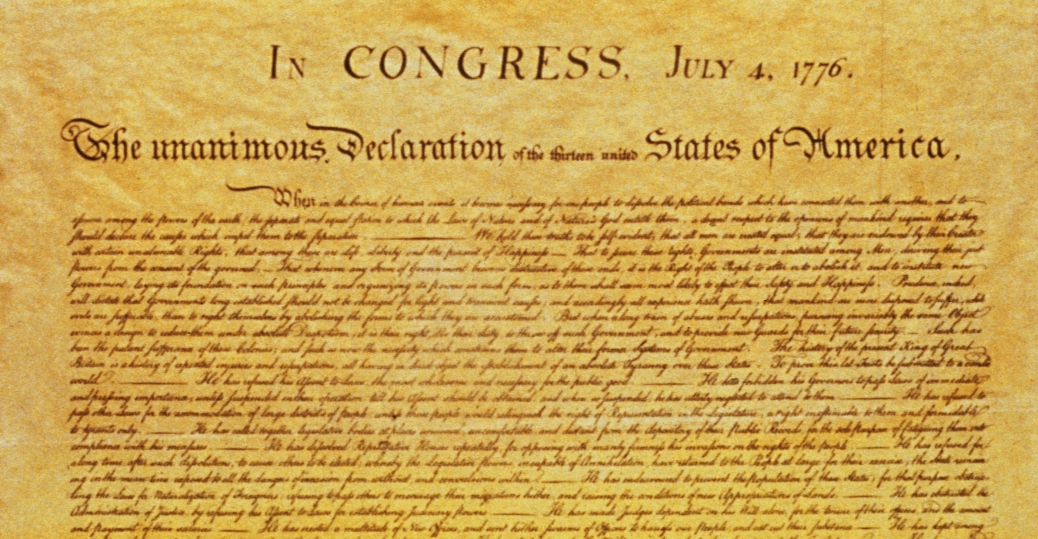

Because of its meager treasury, Congress often failed to pay her, so she paid post riders herself. The war years were tough on Goddard’s businesses.
#DECLARATION OF INDEPENDENCE FULL#
Goddard,” she printed her full name on the document. Though she usually signed her newspaper “M.K. When Congress turned to her to print copies of the Declaration the following year, she recognized her role in a historical moment. Mary Katharine was named Baltimore’s postmaster that October, which likely made her the United States’ only female employee when the nation was born in July 1776. That July, the Continental Congress adopted William Goddard’s postal system, then promptly appointed the more reliable Benjamin Franklin as postmaster general. “The British behaved with savage barbarity,” she wrote in her edition of June 7, 1775.

She published Common Sense in two installments in the paper, and covered the Revolution’s first battles with fervor. In early April 1775, she endorsed the women-led homespun movement against British textiles, encouraging women to raise flax and wool and embrace frugality. By June 1774, she was publishing reports on Britain’s blockade of Boston Harbor. Mary Katharine Goddard took over the Maryland Journal just as the colonists’ anger at British rule surged toward revolution.
#DECLARATION OF INDEPENDENCE FREE#
That allowed him to concentrate on building his most enduring business: a private postal service, free of British control, which later became the U.S. In February 1774, William handed control of his fledgling Maryland Journal over to her. Mary Katharine kept her brother’s businesses running while he did time in debtor’s prison in 17. Miner wrote in his 1962 biography, William Goddard, Newspaperman. “She was dependable and he brilliantly erratic,” Ward L. In 1770, Sarah died, and William, who was feuding with his financial partners, left the Chronicle in his sister’s hands. In 1768, William sold the Providence paper and convinced Sarah and Mary Katharine to move to Philadelphia to help run his Pennsylvania Chronicle. Over the next 15 years, William, a restless and impulsive young entrepreneur, moved from Providence to Philadelphia to Baltimore to start newspapers, always putting his mother or sister in charge of his previous businesses as he went. Murphy in the 1983 book Great Women of the Press, “but displayed from the start his mother’s business sense and his sister’s steadiness.” William, then 21, was listed as publisher. Seven years later, after Giles’s death, the Goddards moved to Providence, and Sarah financed Rhode Island’s first newspaper, the Providence Gazette. Sarah sent Goddard’s younger brother, 15-year-old William, to New Haven to work as a printer’s apprentice. In 1755, the family’s fortunes changed when Goddard’s father, postmaster Giles Goddard, became too ill to work. She also studied Latin, French, and science in New London’s public school, where girls could receive hour-long lessons after the boys’ schooling was done for the day. evidenced that Americans would rather die than live slaves!”īorn June 16, 1738, into a Connecticut family of printers and postmasters, Goddard was taught reading and math by her mother, Sarah, a well-tutored daughter of a wealthy landowner. “What think ye of Congress now? That day. “The ever memorable 19th of April gave a conclusive answer to the questions of American freedom,” Goddard wrote in the Journal after the battles of Lexington and Concord in 1775. In her 23-year publishing career, Goddard earned a place in history as one of the most prominent publishers during the nation’s revolutionary era. She’d editorialized against British brutality, reprinted Thomas Paine’s Common Sense, and published extra editions about Congress’ call to arms and the Battle of Bunker Hill.

At the bottom of the broadside, issued in January 1777, she too signed the Declaration: “Baltimore, in Maryland: Printed by Mary Katharine Goddard.”įor three years after taking over Baltimore’s six-month-old Maryland Journal from her vagabond, indebted brother, Goddard had advocated for the patriot cause. Also Baltimore’s postmaster, she was likely the United States government’s first female employee. Emboldened, the members of Congress ordered a second printing of the Declaration – and, for the first time, printed their names on it.įor the job, Congress turned to one of the most important journalists of America’s Revolutionary era. Weeks later, they learned that the Revolution had turned their way: Washington had crossed the Delaware River on Christmas Day and beaten the redcoats at Trenton and Princeton. As British forces chased George Washington’s Continental Army out of New Jersey in December 1776, a fearful Continental Congress packed the Declaration of Independence into a wagon and slipped out of Philadelphia to Baltimore.


 0 kommentar(er)
0 kommentar(er)
